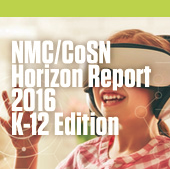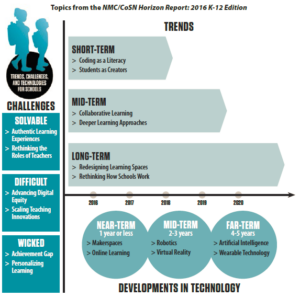What are the late-breaking developments in educational tech? Which innovations are trending in the near term? What is expected to surge and scale in schools? And which innovations promise to swell over the long haul? Are there any surprises? Any ho-hums? The 2016 K12 Horizon Report, after multiple rounds of voting by expert panelists, has a lot to say about what’s percolating in the educational marketplace in the US.

This fall the New Media Consortium (NMC), together with the Consortium for School Networking (COSN), released their annual K12 Horizon Report†, a report which can be very informative for the display industry. And this report has been around a long time. “With more than 14 years of research and publications, it can be regarded as the world’s longest running exploration of emerging technology trends and uptake in education.” The full report can be accessed here. For background information, see my previous two articles on the Ed Market Trends and Ed Market Challenges observed by the Horizon Report.) The following chart helps lay out the big ideas in this report.
Although the 2016 K12 Horizon report largely speaks for itself, in this piece I will offer a bit of translation for and connection to leaders in the large and mobile display industry. With full disclosure I must mention that I served as one of the 50+ panelists who developed this report over many months. Serving as an expert panelist for the both last year’s report and the newest 2016 Horizon K12 report, I think I can add beneficial nuance to the findings, from an inside perspective. So, without further ado, here’s what’s starting to percolate (fresh new developments) in Ed Tech:
Time to Adoption Horizon: One Year or Less
- Makerspaces
- Online Learning
BYOD offered the biggest hoopla last year, but makerspaces are all the craze this year. According to the Horizon Report, makerspaces are “physical environments that offer tools and opportunities for hands-on learn and creation.” Makerspaces, with their design-build philosophy designed to increase exposure to STEM subjects, are springing up in schools and conference sessions everywhere. Here is one makerspace in Singapore, highlighted in the report.
Online learning has seen a strong upswing, as well. According to the Horizon Report, online learning “has experienced a significant surge as more than 2.7 million students in the U.S. alone are taking part.” It is interesting to note that the Horizon Report suggests some real opportunity beckons by coupling online learning with virtual reality. This is an excellent recommendation, a functional pairing. I have been doing this in my online university classes, and I can testify to the strength of this instructional mixture.
Time to Adoption Horizon: Two to Three Years
- Robotics
- Virtual Reality
Robotics has been a hidden undercurrent in schools for more than thirty years. Tucked away in unseen lessons, after-school clubs, and inter-school competitions, robotics is witnessing an unquestionable renaissance in schools and educator conference sessions. Often, robotics is clustered with it close instructional cousins: STEM disciplines, programming (coding), and makerspaces. Here’s a brief look at what robotics can look like in schools. Also see this article, for an understanding of how robotics is playing out at the elementary school level.
Virtual Reality is another new development promising to percolate its way into the classroom in the next two or three years, according to the Horizon Report. Notice the time frame. It is not perceived as a technology that will have an immediate impact, at least for now. But it’s coming. On the positive side, The Horizon report predicts that virtual reality will be an “enabler of student-centered, experiential and collaborative learning”, and a means both to make learning more authentic and storytelling more attention-grabbing.
Time to Adoption Horizon: Four to Five Years
- Artificial Intelligence
- Wearable Technology
Although corporate hiring of artificial intelligence academics is in full swing in unprecedented numbers (e.g., Alphabet recently lured the director of Stanford’s Artificial intelligence lab to head its AI division), AI will take some time to reach schools. The goal of AI in the classroom is to “more intuitively respond to and engage with students.” See What Artificial Intelligence Could Mean for Education.
It also appears that educators are keenly scrutinizing wearable technology, although the time to adoption remains sketchy. This news should delight mobile display manufacturers. Still, no one knows quite for sure what wearable technology will look like in education. For now, the Horizon Report simply suggests that wearable technologies are “well-positioned to advance the ‘quantifiable self’ movement.”
One final gleaning from this year’s Horizon Report is that none of these technologies seem to stand alone. It’s like the pop culture notion of the beloved superhero—sometimes the superhero is more triumphant when working with a partner, a sidekick, an alliance, or a league of heroes. In this way, their superpowers are compounded; their weaknesses bolstered. Similarly, each of the emerging technology developments discussed above is often configured with supporting trends discussed elsewhere in this voluminous report. Each development seems to be carried on the backs of other technologies, resulting in suitable mega-configurations. AI will be advanced by online learning and the “deep learning” movement. Virtual reality will likely join forces online learning and personalized learning. Makerspaces, robotics, coding, authentic learning, cooperative learning, and learning space redesign will successfully aggregate. Wearable technologies will make for a productive symbiont with virtual reality and AI. Clearly, the future lies in the assemblage. –Len Scrogan
† Adams Becker, S., Freeman, A., Giesinger Hall, C., Cummins, M., and Yuhnke, B. (2016). NMC/CoSN Horizon Report: 2016 K-12 Edition. Austin, Texas: The New Media Consortium. Cover Photography BigStock Photography

